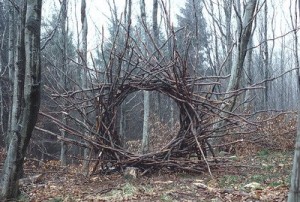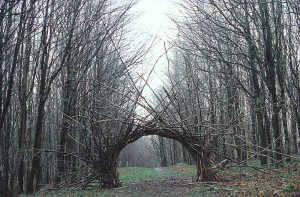Why Jewish Environmental Education Matters
When we hear the words “Jewish environmental education,” we often only hear “environmental education” and not “Jewish education.” It’s easy—too easy—to think of environmental programs as a fun add-on, rather than core, to Jewish learning. That is a mistake. At a time when educators are rethinking the content, methodology and even purpose of Jewish education, Jewish environmental education has much to offer.
Here’s just one example. I was called into Manhattan one chilly fall day to do a training for congregational educators. As usual, I found myself in a roomful of skeptical middle-aged women. While everyone was very pleasant and polite, there was an undertone to the conversation which I am now very familiar with. The unspoken questions: How did I end up being in the group that has to shlep to Central Park instead of the one drinking coffee in a warm room? Is this really going to help me teach the Amidah / the aleph bet / my fourth grade chumash class?
We read a few lines from Bereshit that detail how God created the world, put on our coats and headed out. It was a gorgeous autumn day outside, with sunlight sparkling on leaves in changing colors. When we arrived at the park, there was one of those low, foot-high fences between us and the grassy area I wanted to use. So I asked them, are you ready to hop the fence? They looked at me with more skepticism, but then, with a little nervous laughter, they did it. The minute they got over the fence, it was as if they became different people. The change was incredible. One woman started picking up leaves and throwing them into the air; another scrambled up a tall rock; they all began smiling. It was as if the fence was a literal barrier between their “educator” selves and their more playful selves.
We did our project—a great exercise in nature art based on the work of Andy Goldsworthy—and closed with a discussion around how to create things in this world with more Godly intention. Both our experience and the text from Breishit fueled the discussion. When we went back inside, I couldn’t help asking these women: what happened when you went over the fence? Why did you change? They each had specific reasons, but the general answer was that they felt they were finally being given permission to do something different—given permission to be more expansive in their thinking, more playful, more spiritual.
That fence is a metaphor for the work Jewish environmental educators do. We help connect educators and students with a part of themselves they cannot always access, the part of ourselves we often name “religious” or “spiritual” or “connected.” When we mediate that experience with Jewish study, the effect is to lead participants to a deeper connection to Judaism. Simply taking people out into nature often is the most important part of our work. Too often, we neglect the power of experience, the way that simply going outside enables us to be fully present—brain, heart and hands. Experiential education is a core aspect of Jewish environmental education. Rather than learning an abstract idea, and hoping that the learner has an opportunity to experience the application of the abstract idea at some point in their lives, experiential learning leads with the experience and moves to abstraction afterwards. This engages the intellect, but also creates a physical and emotional connection. At a time when most of us, from children in school to adults at desks, sit indoors all day, getting up out of our chairs provides us with a new lens on the world.
The basis of Jewish environmental learning is the fundamentally Jewish connection to the land and seasons. The three major festivals of the Jewish calendar—Passover, Shavuot, and Sukkot—are all harvest holidays, celebrating our relationship with the land. Our prayers, too, are connected to the outer world. Kabbalat Shabbat, the Friday evening service, centers on the coming of the twilight; the morning prayers praise the Creator for our bodies; the Shema reminds us that God controls the rain and wind, feast and famine. Even the rabbis of the Diaspora who created the Talmud and halakha ( Jewish law) were much more connected to the land than we are now. In order to understand our religion, we must, at the very least, go outside.
We must also learn to reconnect with God. In contemporary Jewish education we are too often afraid to talk about God (or the absence of God) in a personal way. The ultimate abstraction, God is relegated to the loftiest of conversations. Jewish environmental education goes back to Judaism 101 and actively recognizes Divinity in the everyday miracles. It fosters awe and gratitude, radial amazement, and a sense of the interconnectedness of all things. Education of this kind cannot be achieved by one day in the woods or on the farm. While “jumping the fence” is an important start to Jewish environmental education, it is not enough. We can offer great programs to kids who are dropped at our centers for a day’s activities. We can plant seeds that blossom into future learning and seeking. But one program is not going to change anyone’s life, and it’s certainly not enough to comprise an education.
Today, Teva finds itself at the heart of a movement of educators, organizations, and institutions allied with the tenets of Jewish environmental education. Organizations like Teva don’t have the resources to be a school or yeshiva. That is not our mission either. What we are doing is training educators of all stripes in the content and methodologies of Jewish environmental education, and inspiring young adults, our core educators, most of whom never considered going into Jewish education to find jobs in Jewish institutions. Nine new cutting edge Jewish education initiatives have been started by these educators in the past seven years. Teva has also been creating partnerships with Jewish institutions of every stripe, so that the direct programs we offer them spark greater changes within their camps, day schools, congregations, JCCs, seminaries, and centers of Jewish education.
We would like to see this kind of partnership between educators spread until environmental education is integrated into every nook and cranny of institutional Judaism. Which is where it belongs.
![[the current issue of ZEEK]](../../image/2/100/0/5/uploads/leftistethicistgraphic-52842c6a.png)
- 5000 Pages of Zeek
- Founded in 2001, Zeek was the first Jewish online magazine, and we have over 5000 pages online to prove it, all available free of charge. Read more in the Archive.
More articles in
Faith and Practice
- To-Do List for the Social Justice Movement: Cultivate Compassion, Emphasize Connections & Mourn Losses (Don’t Just Celebrate Triumphs)
- Inside the Looking Glass: Writing My Way Through Two Very Different Jewish Journeys
- What Is Mine? Finding Humbleness, Not Entitlement, in Shmita
- Engaging With the Days of Awe: A Personal Writing Ritual in Five Questions
- The Internet Confessional Goes to the Goats



